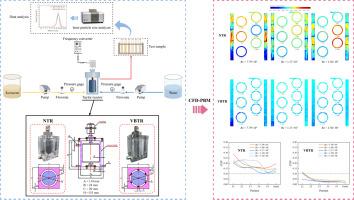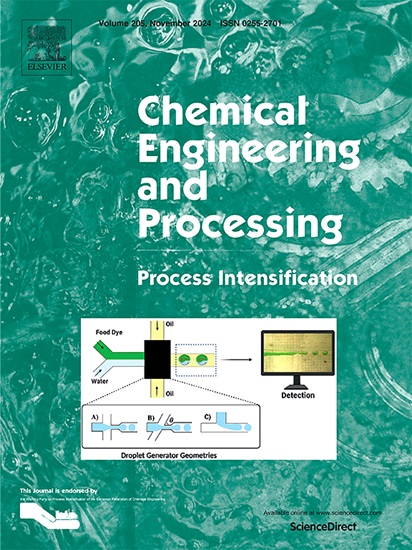Investigation on the effect of vertical baffle plate on droplet size distribution and mixing efficiency in Taylor Reactor
IF 3.8
3区 工程技术
Q3 ENERGY & FUELS
Chemical Engineering and Processing - Process Intensification
Pub Date : 2024-09-28
DOI:10.1016/j.cep.2024.110010
引用次数: 0
Abstract
The Taylor reactor is a dynamic mixer based on the principles of Taylor vortex flow. However, traditional Taylor reactors feature smooth inner and outer cylinder surfaces, presenting challenges in achieving uniform mixing and efficient mass transfer. These limitations do not meet the requirements of modern chemical processes for highly efficient mixing equipment. This article introduces a novel Taylor reactor equipped with vertical baffle plates, designed to overcome these challenges. A comprehensive methodology combining CFD-PBM and experimental techniques was employed to investigate both droplet size distribution and mixing performance in the annular gap. Compared to traditional designs, the new device demonstrates significantly lower COV at 0.018 and Sauter mean diameter at 38.3 μm. Optimal mixing efficiency is achieved at rotating Reynolds number (Re) of 1.17 × 105 and inlet Reynolds number (Rei) of 2.65 × 103. Numerical simulation results suggest that vertical baffles effectively enhance liquid-liquid interactions including collision, interface contact, and droplet residence time within the annular gap. Moreover, increased turbulent stress in the flow field contributes to greater vorticity, turbulence intensity, and turbulent kinetic energy resulting in smaller droplet sizes and improved mixing efficiency. These findings provide a theoretical foundation for hydraulic structural optimization design as well as widespread application of Taylor reactors.

研究垂直挡板对泰勒反应器中液滴粒度分布和混合效率的影响
泰勒反应器是一种基于泰勒涡流原理的动态混合器。然而,传统的泰勒反应器具有光滑的内外圆筒表面,这给实现均匀混合和高效传质带来了挑战。这些局限性无法满足现代化学工艺对高效混合设备的要求。本文介绍了一种配备垂直挡板的新型泰勒反应器,旨在克服这些挑战。采用了一种结合 CFD-PBM 和实验技术的综合方法来研究环形间隙中的液滴粒度分布和混合性能。与传统设计相比,新装置的 COV 值(0.018)和 Sauter 平均直径(38.3 μm)明显降低。在旋转雷诺数(Re)为 1.17 × 105 和入口雷诺数(Rei)为 2.65 × 103 时,可达到最佳混合效率。数值模拟结果表明,垂直挡板有效地增强了环形间隙内的液-液相互作用,包括碰撞、界面接触和液滴停留时间。此外,流场中湍流应力的增加有助于提高涡度、湍流强度和湍流动能,从而减小液滴尺寸并提高混合效率。这些发现为水力结构优化设计以及泰勒反应器的广泛应用提供了理论基础。
本文章由计算机程序翻译,如有差异,请以英文原文为准。
求助全文
约1分钟内获得全文
求助全文
来源期刊
CiteScore
7.80
自引率
9.30%
发文量
408
审稿时长
49 days
期刊介绍:
Chemical Engineering and Processing: Process Intensification is intended for practicing researchers in industry and academia, working in the field of Process Engineering and related to the subject of Process Intensification.Articles published in the Journal demonstrate how novel discoveries, developments and theories in the field of Process Engineering and in particular Process Intensification may be used for analysis and design of innovative equipment and processing methods with substantially improved sustainability, efficiency and environmental performance.

 求助内容:
求助内容: 应助结果提醒方式:
应助结果提醒方式:


